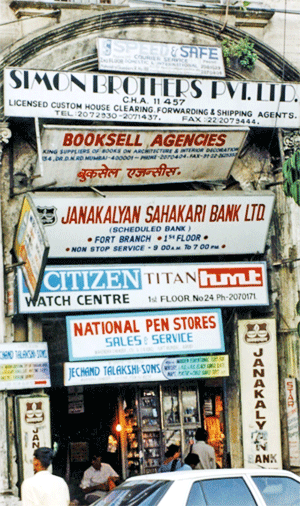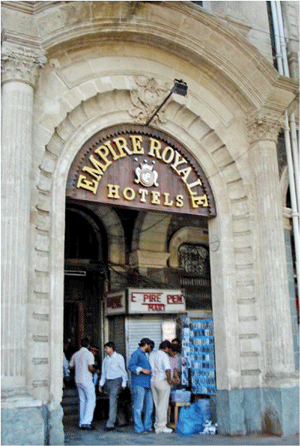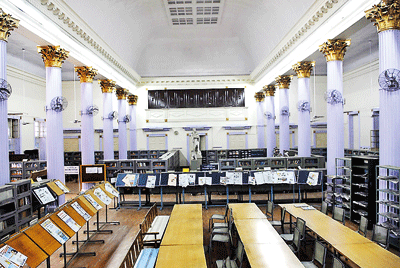Restoring that hidden heritage
 Regarded as one of the foremost conservationists in the sub-continent, Archt. Abha Narain Lambah muses that her favourite projects have been three Buddhist sites, namely the Maitreya Buddha Temple in Ladakh, the Ajanta Caves and Bodhagaya. “I must have some Buddhist karma to get work with all these beautiful sites,” she quips.
Regarded as one of the foremost conservationists in the sub-continent, Archt. Abha Narain Lambah muses that her favourite projects have been three Buddhist sites, namely the Maitreya Buddha Temple in Ladakh, the Ajanta Caves and Bodhagaya. “I must have some Buddhist karma to get work with all these beautiful sites,” she quips.Delivering the annual Geoffrey Bawa lecture on July 28 at the Sri Lanka Foundation Institute, she credited Bawa as one of the reasons she decided to become an architect.

An assortment of nameboards mask a building’s facade (above) and (right) Stripped of clutter: The same building’s colonial architecture clearly visible
Having received her Master’s degree in architectural conservation from the School of Planning & Architecture, New Delhi, Lambah has worked tirelessly for the past 22 years to conserve the architectural heritage of both India’s colonial and pre-colonial past. Her work has been far-ranging across India from Bodha Gaya and Ajanta, to the Royal Opera House in New Delhi and the University of Mumbai’s Convocation Hall.
In 2007 Lambah won the UNESCO Asia Pacific Heritage Conservation Award Of Excellence for her restoration work on the Maitreya Temple in Ladakh, India. This ancient temple made of mud and wood, dating back to the 16th Century, was placed on the watchlist of the 100 most endangered buildings by the World Monument Fund in 2000 and 2002. Situated in a high altitude desert region which is prone to huge drops in temperature (minus 30 degrees at times),the task was not easy. The harsh winters meant that work could only take place between May and October of each year, resulting in the project taking three years to complete.
Yet with no electricity, running water, or roads aside from footpaths, Lambah persevered using local labour, materials and techniques to restore the temple and prevent its collapse. “You’re not just conserving a building, but an identity; a way of life,” she explains.
Lambah was later appointed to work on the management plans for the Ajanta caves and Bodha Gaya. During this time she began to question whether a South Asian Charter to conservation should be formulated, especially in relation to religious and sacred sites, instead of relying on Western Charters. The dilemma faced during the formulation of the management plan for Bodha Gaya when a group of Thai donors proposed to gold plate the ‘amlak’ of the Mahabodhi Temple, makes a case for the adoption of the charter. The issue which arose from the proposal was whether a world heritage site should be changed for reasons not concerned with safety or extending its lifetime. To allow the alteration would be to go against the charters on conservation and the principles of conservation.
 The management committee did allow it. The reasoning behind this decision Lambah explains, is because the temple is what she calls a ‘living tradition’, and to prevent these changes would be to freeze it in time. “How far do you go as a trained professional and where do you step back and let faith take over?” she asks; a question she says she still hasn’t found the answer for.
The management committee did allow it. The reasoning behind this decision Lambah explains, is because the temple is what she calls a ‘living tradition’, and to prevent these changes would be to freeze it in time. “How far do you go as a trained professional and where do you step back and let faith take over?” she asks; a question she says she still hasn’t found the answer for.
Her approach to conservation, especially of our colonial past is that of preservation, accessability and adaptive reuse. According to Lambah, historical buildings shouldn’t be put into isolated pockets, as this disconnects it from people. Instead you must weave in its relevance and create public engagement. This can be achieved by adaptive reuse, explains Lambah bringing in examples of Museum Cafes and the repurposing of disused industrial buildings as a school– a concept which has been embraced by Sri Lanka in the recent years with projects such as Trace City, the Dutch Hospital and the Race Course shopping complexes.
Lambah says the concept of contextual architecture that Geoffrey Bawa introduced to Sri Lanka has meant that the design voice in the island has not been consumed by commercial chaos and urban confusion that present day Indian cities have succumbed to. Therefore in this respect Lambah believes India has much to learn from Sri Lanka.

The Public Library in Mumbai: Before (above) and after restoration (below)
The lack of funding, the push and pull between development and conservation and myopic urban planning has led to cities such as Mumbai losing a large portion of its colonial architectural heritage, she feels. Determined to prevent further degradation to Mumbai’s colonial heritage, Lambah together with volunteer groups and NGOs took up the challenge to reclaim their heritage. With virtually no government support, they started on a grassroot level, and began negotiating with shopkeepers in the commercial district to alter and adapt their signboards so as to allow the detailed facades of the old Victorian buildings to be seen. These simple changes were transformational. Emboldened they began collecting funds to restore the outer facades as well as the interiors of public buildings including the Public Library. With just a change of lighting, re-routing of wires, the elimination of old furniture and fixtures as well as removing layers of old paint these dilapidated public spaces were transformed to spaces one would typically see in Europe. “It’s mostly about undoing the wrongs done,” she humbly says with regard to restoring colonial buildings. What is required she says is mostly community engagement, and that the rest will follow.
 Lambah is unfazed by the fact that she is a woman in a male dominated industry, believing that she faces the same challenges anyone else would in the industry “ I never felt as if I was privileged or under privileged,” she says. Once you remove the gender distinction from your mind, so will others, respecting you for your work and abilities rather than judging you based on your gender. An outlook that has served her well as over the years–she’s been awarded the Sanskriti Award, Eisenhower Fellowship, the Attingham Trust Fellowship and Charles Wallace Fellowship and has been a consultant to ICCROM, UNITAR, World Monuments Fund, Global Heritage Fund, Archaeological Survey of India and various state governments and organizations. She has also authored various books on Architectural History & Conservation, including “A City’s Legacy:The Indian Navy’s Heritage in Mumbai” and “Conservation After Legislation: Issues for Mumbai”, among others.
Lambah is unfazed by the fact that she is a woman in a male dominated industry, believing that she faces the same challenges anyone else would in the industry “ I never felt as if I was privileged or under privileged,” she says. Once you remove the gender distinction from your mind, so will others, respecting you for your work and abilities rather than judging you based on your gender. An outlook that has served her well as over the years–she’s been awarded the Sanskriti Award, Eisenhower Fellowship, the Attingham Trust Fellowship and Charles Wallace Fellowship and has been a consultant to ICCROM, UNITAR, World Monuments Fund, Global Heritage Fund, Archaeological Survey of India and various state governments and organizations. She has also authored various books on Architectural History & Conservation, including “A City’s Legacy:The Indian Navy’s Heritage in Mumbai” and “Conservation After Legislation: Issues for Mumbai”, among others.
Her firm has won eight UNESCO Asia Pacific Awards for heritage conservation and having achieved so much already, Lambah says that she is at that point in her career where she should pause and re-evaluate the work she’s done. But with her idols like Charles Corea, Joseph Stein and Bawa, who worked well into their 80s, she has no intention of stopping anytime soon.
For a detailed report on the lecture delivered by Architect Abha Narain Lambah at the Geoffrey Bawa Memorial Lecture check our website www.sundaytimes.lk


